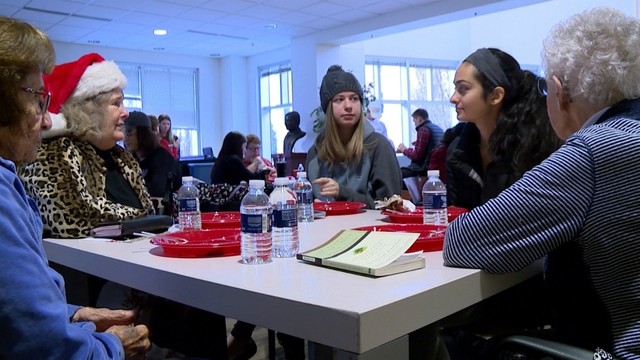‘Saging and Aging’ encourages intergenerational dialogue

Courtesy / Wood TV 8
Jan 7, 2019
The United States Census Bureau estimates that the number of citizens aged 65 or older will almost double by 2060, hitting a record number of 98.2 million — the equivalent of one quarter of the total U.S. population.
For the second year in a row, Grand Valley State University students have gotten the opportunity to explore the effects of a rapidly growing elderly population, as well as how senior citizens could be utilized as a resource to society throughout the honors ‘Saging and Aging’ course.
Instructed by Professor Jane Toot, the course is unique in that freshman honors students learn alongside senior citizens from local assisted living communities. According to Toot, similar courses are offered in parts of Europe, such as Ireland and the Netherlands, but the idea to directly integrate different generations in a college course remains fairly new in the United States.
Toot said that she wishes to ignite an awareness about the elderly with this course.
“While elders may have problems, they are not a problem,” Toot said. “We (as Americans) don’t utilize the resources right in front of our faces… We don’t regard the elderly as sages (holders of wisdom).”
In addition, Toot said she hopes the course can demonstrate to senior citizens that their preconceived notions about the younger generation may not be true.
“It’s an effort to demonstrate that all the elderly hear on television isn’t true,” Toot said. “Younger people really can be interested in the lives of the elderly and social causes.”
The course, which met twice per week during the fall semester, had an approximately equal number of traditional, college freshman students and senior citizens. One day per week was largely dedicated to discussion and lecture on a variety of topics, including caregiving, technology, spiritualism and retirement. During the other meeting time, traditional students engaged in discussions with their intergenerational team — asking the senior citizens questions about their experiences related to the lecture topics.
According to Toot, this interactive time prompted an exchange of ideas and an interest in the other generation.
“A traditional student may ask how their doctor appointment went, and an older person may ask the traditional student, ‘Are you still dating that boy I told you wasn’t any good for you?’” Toot said. “It’s a give and take.”
Freshman honors student Emma Cubitt said that she felt the course changed her perspective on the elderly.
“This course has changed my perspective on elders because I can see issues with many places and facilities that could improve convenience and safety for elders,” Cubitt said.
Part of the course focused on discovering ways to improve the local community to become more accommodating to the elderly; the city of Grand Rapids is currently striving to obtain the World Health Organization’s classification of being an elderly-friendly community.
According to Toot, some ways to make the local community more elderly-friendly may be as simple as adding more benches and ensuring handicapped parking spaces are properly salted and plowed after snowstorms.
While Toot acknowledged that this course was not an easy class to run — meeting times had to be scheduled carefully in order to not interfere with morning doctor appointments and early bedtimes of the senior citizens — she said, “I’ve never had this much fun teaching before.”
Toot said she is unsure if this course will be slated to continue in future years at GVSU, but hopes it will.
“This isn’t just a health class,” Toot said. “I have students who are going into hospitality tourism and management, finance… We are all going to be faced with (aging), whether it’s our family or the career we go into.”























